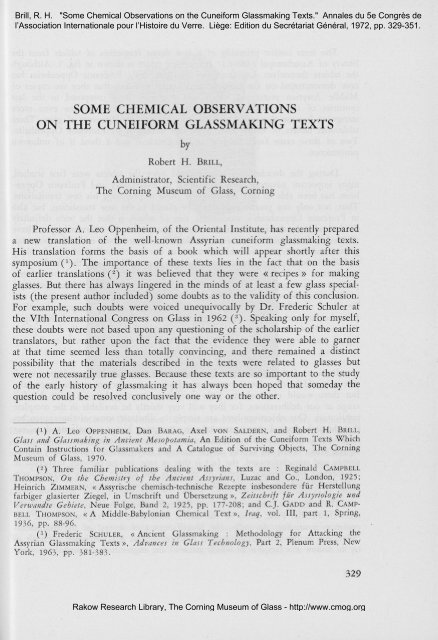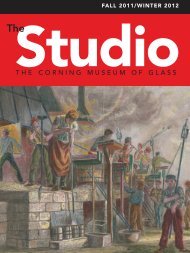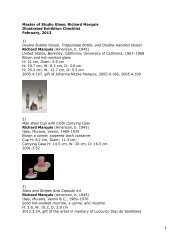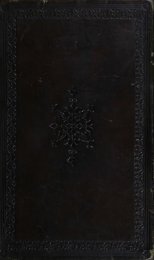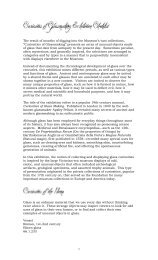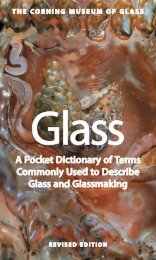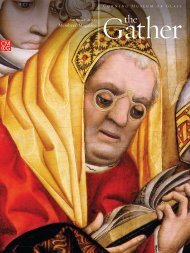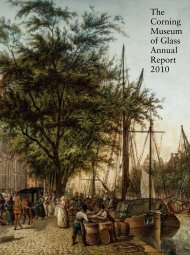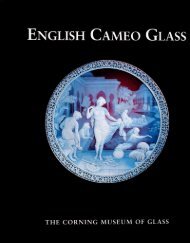"Some Chemical Observations on the Cuneiform Glassmaking Texts."
"Some Chemical Observations on the Cuneiform Glassmaking Texts."
"Some Chemical Observations on the Cuneiform Glassmaking Texts."
- TAGS
- www.cmog.org
You also want an ePaper? Increase the reach of your titles
YUMPU automatically turns print PDFs into web optimized ePapers that Google loves.
Brill, R. H. "<str<strong>on</strong>g>Some</str<strong>on</strong>g> <str<strong>on</strong>g>Chemical</str<strong>on</strong>g> <str<strong>on</strong>g>Observati<strong>on</strong>s</str<strong>on</strong>g> <strong>on</strong> <strong>the</strong> <strong>Cuneiform</strong> <strong>Glassmaking</strong> <strong>Texts</strong>." Annales du 5e C<strong>on</strong>grès de<br />
l’Associati<strong>on</strong> Internati<strong>on</strong>ale pour l’Histoire du Verre. Liège: Editi<strong>on</strong> du Secrétariat Général, 1972, pp. 329-351.<br />
SOME CHEMICAL OBSERVATIONS<br />
ON THE CUNEIFORM GLASSMAKING TEXTS<br />
by<br />
Robert H. BRILL,<br />
Administrator, Scientific Research,<br />
The Corning Museum of Glass, Corning<br />
Professor A. Leo Oppenheim, of <strong>the</strong> Oriental Institute, has recently prepared<br />
a new translati<strong>on</strong> of <strong>the</strong> well-known Assyrian cuneiform glassmaking texts.<br />
His translati<strong>on</strong> forms <strong>the</strong> basis of a book which will appear shortly after this<br />
symposium ('). The importance of <strong>the</strong>se texts lies in <strong>the</strong> fact that <strong>on</strong> <strong>the</strong> basis<br />
of earlier translati<strong>on</strong>s (2) it was believed that <strong>the</strong>y were «recipes» for making<br />
glasses. But <strong>the</strong>re has always lingered in <strong>the</strong> minds of at least a few glass specialists<br />
(<strong>the</strong> present author included) some doubts as to <strong>the</strong> validity of this c<strong>on</strong>clusi<strong>on</strong>.<br />
For example, such doubts were voiced unequivocally by Dr. Frederic Schuler at<br />
<strong>the</strong> VIth Internati<strong>on</strong>al C<strong>on</strong>gress <strong>on</strong> Glass in 1962 (S). Speaking <strong>on</strong>ly for myself,<br />
<strong>the</strong>se doubts were not based up<strong>on</strong> any questi<strong>on</strong>ing of <strong>the</strong> scholarship of <strong>the</strong> earlier<br />
translators, but ra<strong>the</strong>r up<strong>on</strong> <strong>the</strong> fact that <strong>the</strong> evidence <strong>the</strong>y were able to garner<br />
at "that time seemed less than totally c<strong>on</strong>vincing, and <strong>the</strong>re remained a distinct<br />
possibility that <strong>the</strong> materials described in <strong>the</strong> texts were related to glasses but<br />
were not necessarily true glasses. Because <strong>the</strong>se texts are so important to <strong>the</strong> study<br />
of <strong>the</strong> early history of glass making it has always been hoped that someday <strong>the</strong><br />
questi<strong>on</strong> could be resolved c<strong>on</strong>clusively <strong>on</strong>e way or <strong>the</strong> o<strong>the</strong>r.<br />
(1) A. Leo OPPENHEIM, Dan BARAG, Axel VON SALDERN, and Robert H . BRILL,<br />
Glass and <strong>Glassmaking</strong> in Ancient Mesopotamia, An Editi<strong>on</strong> of <strong>the</strong> <strong>Cuneiform</strong> <strong>Texts</strong> Which<br />
C<strong>on</strong>tain Instructi<strong>on</strong>s for Glassmakers and A Catalogue of Surviving Objects, The Corning<br />
Museum of Glass, 1970.<br />
(2) Three familiar publicati<strong>on</strong>s dealing with <strong>the</strong> texts are Reginald CAMPBELL<br />
THOMPSON, On <strong>the</strong> Chemistry of <strong>the</strong> Ancient Assyrians, Luzac and Co., L<strong>on</strong>d<strong>on</strong>, 1925;<br />
Heinrich ZIMMERN, « Assyrische chemisch-technische Rezepte insbes<strong>on</strong>dere fur Herstellung<br />
farbiger g lasierter Ziegel, in Umschrift und trbersetzung », Zeitschrift fur AssY1-iologie und<br />
Verwandte Gebiete, Neue Folge, Band 2, 1925, pp. 177-208; and c.]. GADD and R. CAMP<br />
BELL THOMPSON, « A Middle-Babyl<strong>on</strong>ian <str<strong>on</strong>g>Chemical</str<strong>on</strong>g> Text », Iraq, vol. III, part 1, Spring,<br />
1936, pp. 88-96.<br />
(3) Frederic SCHULER, « Ancient <strong>Glassmaking</strong> Methodology for Attacking <strong>the</strong><br />
Assyrian <strong>Glassmaking</strong> <strong>Texts</strong> », Advances in Glass Technology, Part 2, Plenum Press, New<br />
York, 1963, pp. 381-383 .<br />
329<br />
Rakow Research Library, The Corning Museum of Glass - http://www.cmog.org
Brill, R. H. "<str<strong>on</strong>g>Some</str<strong>on</strong>g> <str<strong>on</strong>g>Chemical</str<strong>on</strong>g> <str<strong>on</strong>g>Observati<strong>on</strong>s</str<strong>on</strong>g> <strong>on</strong> <strong>the</strong> <strong>Cuneiform</strong> <strong>Glassmaking</strong> <strong>Texts</strong>." Annales du 5e C<strong>on</strong>grès de<br />
l’Associati<strong>on</strong> Internati<strong>on</strong>ale pour l’Histoire du Verre. Liège: Editi<strong>on</strong> du Secrétariat Général, 1972, pp. 329-351.<br />
The texts c<strong>on</strong>sist primarily of a few dozen fragments of tablets from <strong>the</strong><br />
library of Assurbanipal (668-627 B.C). One tablet is shown in fig. 1. Although<br />
<strong>the</strong> tablets <strong>the</strong>mselves date from <strong>the</strong> 7th cent. B.C, Professor Oppenheim has<br />
now dem<strong>on</strong>strated <strong>on</strong> <strong>the</strong> basis of philological evidence that <strong>the</strong>y are copies of<br />
Middle Assyrian prototypes which had originally been composed in <strong>the</strong> last<br />
centuries of <strong>the</strong> sec<strong>on</strong>d millennium B.C Thus <strong>the</strong> texts become even more<br />
intriguing because <strong>the</strong>y carry us back still closer to <strong>the</strong> discovery of glass. Three<br />
additi<strong>on</strong>al tablets of earlier date were also translated by Professor Oppenheim.<br />
Two of <strong>the</strong>se came from Babyl<strong>on</strong> and Boghazkeui and a third if of unknown<br />
provenience.<br />
During <strong>the</strong> decades that have elapsed since <strong>the</strong> tablets were first studied,<br />
many important advances have been made in Assyriology and Professor Oppenheim<br />
has been able to take advantage of <strong>the</strong>se in preparing his new translati<strong>on</strong>s.<br />
Thus, not <strong>on</strong>ly can greater c<strong>on</strong>fidence be placed in <strong>the</strong> new translati<strong>on</strong>, but also<br />
in Professor Oppenheim's c<strong>on</strong>clusi<strong>on</strong>s, <strong>on</strong>e of which is that <strong>the</strong> texts definitely<br />
do deal with <strong>the</strong> making of various colored glasses. But <strong>the</strong> intervening years have<br />
also led to <strong>the</strong> acquisiti<strong>on</strong> of new archae logical evidence about early Mesopotamian<br />
glasses and to very c<strong>on</strong>siderable advances in our understanding of <strong>the</strong> chemistry<br />
and <strong>the</strong> technology of glassmaking in early times. Therefore, <strong>the</strong> forthcoming<br />
publicati<strong>on</strong> of Professor Oppenheim's work will be accompanied by a comprehensive<br />
catalogue of early Mesopotamian glasses and a chemical interpretati<strong>on</strong><br />
of his translati<strong>on</strong>s. The catalogue has been prepared by Dr. Dan Barag and<br />
Dr. Axel v<strong>on</strong> Said ern and <strong>the</strong> chemical interpretati<strong>on</strong>s by <strong>the</strong> present author.<br />
It is <strong>the</strong> latter, <strong>the</strong> chemical interpretati<strong>on</strong>s, which are <strong>the</strong> subject of this paper.<br />
Whereas Professor Oppenheim's c<strong>on</strong>clusi<strong>on</strong>s were drawn essentially from philological<br />
reas<strong>on</strong>ing, ' <strong>the</strong> inferences we shall discuss here were drawn from chemical<br />
reas<strong>on</strong>ing, and as such <strong>the</strong>y c<strong>on</strong>stitue a complementary body of evidence.<br />
Because of <strong>the</strong> great interest in <strong>the</strong>se texts am<strong>on</strong>g glass specialists, we felt<br />
that it would be of value to present our findings as a lecture at this symposium.<br />
But <strong>the</strong>re would obviously be little point to reiterating here in print <strong>the</strong> full<br />
range of our deliberati<strong>on</strong>s, for <strong>the</strong>y will very shortly be available in <strong>the</strong> complete<br />
publicati<strong>on</strong>. Our objectives here are simply to illustrate some of <strong>the</strong> approaches<br />
that <strong>the</strong> archaelogical chemist can take in attempting better to understand ancient<br />
texts such as <strong>the</strong>se, and to summarize some of <strong>the</strong> c<strong>on</strong>clusi<strong>on</strong>s drawn in <strong>the</strong> course<br />
of our work. While <strong>the</strong> brevity of this summary may make <strong>the</strong> entire study appear<br />
simple and straightforward, <strong>the</strong> fact is that as so<strong>on</strong> as <strong>on</strong>e becomes immersed in<br />
interpreting <strong>the</strong> chemical aspects of <strong>the</strong> texts <strong>the</strong> subject quickly becomes very<br />
complicated and <strong>on</strong>e fraught with many unsuspected difficulties.<br />
There are two major sources of difficulty encountered in interpreting <strong>the</strong><br />
texts chemically. First, many of <strong>the</strong> tablets <strong>the</strong>mselves are fragmentary and thus<br />
evidence is missing. Sec<strong>on</strong>dly, <strong>the</strong> identificati<strong>on</strong>s of several of <strong>the</strong> ingredients<br />
called for by <strong>the</strong> instructi<strong>on</strong>s remain obscure - and it is obviously difficult to<br />
try to follow a «recipe» in which some of <strong>the</strong> ingredients are unknown. Over<br />
330<br />
Rakow Research Library, The Corning Museum of Glass - http://www.cmog.org
Brill, R. H. "<str<strong>on</strong>g>Some</str<strong>on</strong>g> <str<strong>on</strong>g>Chemical</str<strong>on</strong>g> <str<strong>on</strong>g>Observati<strong>on</strong>s</str<strong>on</strong>g> <strong>on</strong> <strong>the</strong> <strong>Cuneiform</strong> <strong>Glassmaking</strong> <strong>Texts</strong>." Annales du 5e C<strong>on</strong>grès de<br />
l’Associati<strong>on</strong> Internati<strong>on</strong>ale pour l’Histoire du Verre. Liège: Editi<strong>on</strong> du Secrétariat Général, 1972, pp. 329-351.<br />
Fig. 1<br />
Fig. 2<br />
and above this Professor Oppenheim has cauti<strong>on</strong>ed us that <strong>the</strong> texts are essentially<br />
literary in character and were not at all intended to be explicit step-by-step recipes<br />
or instructi<strong>on</strong>s that <strong>the</strong> glassmakers would follow out in order to make <strong>the</strong>ir<br />
materials. Therefore, <strong>on</strong>e must avoid <strong>the</strong> temptati<strong>on</strong> to take <strong>the</strong>se texts too literally.<br />
Despite <strong>the</strong>se difficulties, however, and o<strong>the</strong>rs, we believe we were able to<br />
dem<strong>on</strong>strate chemically that <strong>the</strong> texts are c<strong>on</strong>cerned with <strong>the</strong> manufacture of true<br />
glassy materials. Strictly speaking, we cannot claim absolute c<strong>on</strong>fidence in <strong>the</strong>se<br />
c<strong>on</strong>clusi<strong>on</strong>s as l<strong>on</strong>g as a significant number of ingredients remain unidentified,<br />
but we feel that <strong>the</strong> case is so str<strong>on</strong>g that it can be stated with little reservati<strong>on</strong>.<br />
In general, our c<strong>on</strong>clusi<strong>on</strong>s were drawn from four types of c<strong>on</strong>siderati<strong>on</strong>s.<br />
To illustrate <strong>the</strong>se we are including here : (1) <str<strong>on</strong>g>Some</str<strong>on</strong>g> very brief comments <strong>on</strong><br />
<strong>the</strong> general scheme of <strong>the</strong> texts and <strong>the</strong> ingredients used, (2) <strong>the</strong> results of a<br />
Rakow Research Library, The Corning Museum of Glass - http://www.cmog.org<br />
331
Brill, R. H. "<str<strong>on</strong>g>Some</str<strong>on</strong>g> <str<strong>on</strong>g>Chemical</str<strong>on</strong>g> <str<strong>on</strong>g>Observati<strong>on</strong>s</str<strong>on</strong>g> <strong>on</strong> <strong>the</strong> <strong>Cuneiform</strong> <strong>Glassmaking</strong> <strong>Texts</strong>." Annales du 5e C<strong>on</strong>grès de<br />
l’Associati<strong>on</strong> Internati<strong>on</strong>ale pour l’Histoire du Verre. Liège: Editi<strong>on</strong> du Secrétariat Général, 1972, pp. 329-351.<br />
calculati<strong>on</strong>, and (3) <strong>the</strong> results of a laboratory experiment c<strong>on</strong>ducted by following<br />
out <strong>the</strong> instructi<strong>on</strong>s given in <strong>on</strong>e part of <strong>the</strong> texts. It is also important to note<br />
that we have not been able to find any c<strong>on</strong>tradictory evidence, that is, evidence<br />
that would support uniquely a view that <strong>the</strong> texts describe <strong>the</strong> preparati<strong>on</strong> of any<br />
material o<strong>the</strong>r than glasses.<br />
The general schemes of <strong>the</strong> procedures described in <strong>the</strong> texts, as well as<br />
many of <strong>the</strong> details, make sound glass making sense. In fact, if <strong>on</strong>e were to set<br />
out today to make small quantities of, let us say, a green or red opaque glass in<br />
a backyard operati<strong>on</strong>, <strong>the</strong> schemes proposed by <strong>the</strong> texts are just about what <strong>on</strong>e<br />
with some glassmaking experience would devise.<br />
The ingredients specified - as far as <strong>the</strong>y can be identified - are those<br />
we believe were used for making glass in ancient Mesopotamia. Not <strong>on</strong>ly are<br />
<strong>the</strong> ingredients reas<strong>on</strong>able, but, with a few excepti<strong>on</strong>s, <strong>the</strong>y are used in reas<strong>on</strong>able<br />
proporti<strong>on</strong>s. Also, <strong>the</strong> total quantities of materials involved are about what we<br />
feel <strong>the</strong> glassmakers of those times could have managed to deal with.<br />
One particular part of <strong>the</strong> texts describes <strong>the</strong> preparati<strong>on</strong> of a material called<br />
zukt2. From <strong>the</strong> general scheme of <strong>the</strong> c<strong>on</strong>text, it is apparent that zukt2 is an<br />
intermediate product. It is prepared by reacting a mineral immanakku (which<br />
I believe to be quartzite pebbles), with ahussu, <strong>the</strong> ashes of <strong>the</strong> naga plant. The<br />
reactants are ground separately, <strong>the</strong>n mixed and placed in a kiln. The mixture<br />
is heated at a moderate temperature (red heat), removed from <strong>the</strong> kiln, cooled<br />
and ground (4). Then <strong>the</strong> material is placed in <strong>the</strong> kiln and heated again, this<br />
time to a higher temperature (yellow heat), and poured out <strong>on</strong>to a fired brick.<br />
Looking at glassmaking as a pyrotechnological process, this procedure would<br />
have allowed <strong>the</strong> glassmaker to accomplish <strong>the</strong> most difficult chemical step of<br />
<strong>the</strong> process, that is, <strong>the</strong> combinati<strong>on</strong> of his silica-bearing ingredient with alkali<br />
to produce a more or less homogeneous, <strong>on</strong>e-phase system. Having accomplished<br />
this he could <strong>the</strong>n work with his zukt2 being able to c<strong>on</strong>centrate <strong>on</strong> <strong>the</strong> more<br />
subtle chemical steps of adding colorants and opacifiers, which, in fact, is exactly<br />
what <strong>the</strong> following secti<strong>on</strong>s of <strong>the</strong> texts tell him to do.<br />
These particular secti<strong>on</strong>s of <strong>the</strong> text are well preserved and <strong>the</strong> ingredients<br />
can be identified with some c<strong>on</strong>fidence, and so <strong>the</strong>y were selected for thorough<br />
study. By assuming that <strong>the</strong> immanakku mineral could be approximated by<br />
quartzite pebbles, and that <strong>the</strong> ash of <strong>the</strong> naga plant could be approximated by<br />
a composite compositi<strong>on</strong> derived from those of analyzed plant ashes, we calculated<br />
a <strong>the</strong>oretical compositi<strong>on</strong> for zukt2 using <strong>the</strong> quantities of ingredients specified<br />
by <strong>the</strong> instructi<strong>on</strong>s. (A typical plant specimen is illustrated in fig. 2.) The<br />
compositi<strong>on</strong> calculated for zukt2 agrees very well with analyzed compositi<strong>on</strong>s of<br />
early Mesopotamian glasses, if <strong>on</strong>e makes allowances for <strong>the</strong> subsequent additi<strong>on</strong>s<br />
of colorants and opacifiers. (See table 1.)<br />
('1) This procedure would serve <strong>the</strong> purpose of opening up <strong>the</strong> reacti<strong>on</strong> between <strong>the</strong><br />
silica and alkali, and would expel <strong>the</strong> gaseous reacti<strong>on</strong> products from <strong>the</strong> system. In practice<br />
it would probably have been c<strong>on</strong>trolled so as to have left <strong>the</strong> materials as a partially reacted,<br />
friable mass which today is called a frit.<br />
332<br />
Rakow Research Library, The Corning Museum of Glass - http://www.cmog.org
Brill, R. H. "<str<strong>on</strong>g>Some</str<strong>on</strong>g> <str<strong>on</strong>g>Chemical</str<strong>on</strong>g> <str<strong>on</strong>g>Observati<strong>on</strong>s</str<strong>on</strong>g> <strong>on</strong> <strong>the</strong> <strong>Cuneiform</strong> <strong>Glassmaking</strong> <strong>Texts</strong>." Annales du 5e C<strong>on</strong>grès de<br />
l’Associati<strong>on</strong> Internati<strong>on</strong>ale pour l’Histoire du Verre. Liège: Editi<strong>on</strong> du Secrétariat Général, 1972, pp. 329-351.<br />
TABLE 1 (')<br />
Compositi<strong>on</strong> « Typical» Analyses Hypo<strong>the</strong>tical Compositi<strong>on</strong><br />
Assumed of Mesopotamian Mesopotamian Calculated<br />
fo r ahussu ( 2) Glasses (3) «Base Glass» (4) for zuki2 (5)<br />
Na20 34.5 % Si02 55 64% 68 56 66 '% 70 56.0 %<br />
KzO 5.20 Na20 13 16 19 14 17 20 23.8<br />
CaO 9 .20 CaO 4 6.5 8 4 7 10 6.6<br />
MgO 7.80<br />
Al 2 0 3 1.10 K20 1 1.5 3 1 1.5 3 3.8<br />
MgO 3 4.5 6 3 4.5 6 5.6<br />
24.0<br />
3.20 A lz0 3 1.5 2 3 1.5 2 3 2.2<br />
6.20 Fe Z0 3 0.5 1 1.5 0.5 1 1.5 0.7<br />
1.50 T i0 2 0.1 0. 1 0.05<br />
FezO3 0.6 MnO var. 0.02 0.05<br />
MnO<br />
Ti02<br />
0. 1<br />
0. 1<br />
Sb20 5<br />
PbO<br />
var.<br />
var.<br />
O.OOX( ?)<br />
O.OOOX( ?)<br />
nil<br />
nil<br />
Si0 2 3.0<br />
Li20 - BaO --,0.1 --,0.1 --,0.1<br />
BaO 0.2 SrO --,0.1 --,0.1 --,0.1<br />
SrO 0.2<br />
B20 3<br />
Zr02<br />
-<br />
--<br />
PZ0 5<br />
S03<br />
--,0.3<br />
--,0.3<br />
--,0.3<br />
--,0.3<br />
1.0<br />
--,0.5(?)<br />
PbO -- Cl --,0.3 --,0.3 --,0.5 (?)<br />
« Oth er» 3.1<br />
Na?O/ K2O 6.64<br />
lAsh Residue --' 37<br />
NOTES TO ACCOMPANY TABLE 1<br />
(1) Informati<strong>on</strong> taken from «The <str<strong>on</strong>g>Chemical</str<strong>on</strong>g> Interpretati<strong>on</strong> of <strong>the</strong> <strong>Texts</strong> », Glass and<br />
<strong>Glassmaking</strong> in Ancient Mesopotamia. (See complete reference in footnote no. 1.)<br />
(2) This is a composite of values estimated from analyses of specimens of plant ashes.<br />
( 3) The compositi<strong>on</strong>s of early Mesopotamian glasses valY c<strong>on</strong>siderably with period<br />
and color. The values given are meant to represent typical values and <strong>the</strong> approximate ranges<br />
found. var. indicates elements which are variable depending up<strong>on</strong> <strong>the</strong> color of <strong>the</strong> glasses.<br />
(4) This is a hypo<strong>the</strong>tical compositi<strong>on</strong> (typical values and ranges) for a colorless<br />
« base glass» to which could have been added various colorants and opacifiers in order<br />
to produce glasses having <strong>the</strong> analyzed compositi<strong>on</strong>s listed in <strong>the</strong> previous column. The<br />
nominal values in <strong>the</strong> previous column were used for calculating <strong>the</strong> values for <strong>the</strong> hypo<strong>the</strong>tical<br />
«base glass ». I<br />
(5) Calculated by assuming <strong>the</strong> proporti<strong>on</strong>s given in secti<strong>on</strong>s 1 and 4 of <strong>the</strong> cuneiform<br />
texts. (See note 1.) The immanakku mineral was assumed to have <strong>the</strong> following compositi<strong>on</strong><br />
Si02 = 95.0 percent, Alz0 3 = 2.5 percent, Fe Z0 3 , CaO, MgO, NazO and K 20<br />
= 0.5 percent each. The ahussu compositi<strong>on</strong> used was that given in <strong>the</strong> first column of<br />
th is table. The mineral:ash ratio was assumed to be 10:12.<br />
Rakow Research Library, The Corning Museum of Glass - http://www.cmog.org
Brill, R. H. "<str<strong>on</strong>g>Some</str<strong>on</strong>g> <str<strong>on</strong>g>Chemical</str<strong>on</strong>g> <str<strong>on</strong>g>Observati<strong>on</strong>s</str<strong>on</strong>g> <strong>on</strong> <strong>the</strong> <strong>Cuneiform</strong> <strong>Glassmaking</strong> <strong>Texts</strong>." Annales du 5e C<strong>on</strong>grès de<br />
l’Associati<strong>on</strong> Internati<strong>on</strong>ale pour l’Histoire du Verre. Liège: Editi<strong>on</strong> du Secrétariat Général, 1972, pp. 329-351.<br />
Having gained some c<strong>on</strong>fidence from <strong>the</strong> results of <strong>the</strong>se calculati<strong>on</strong>s we<br />
<strong>the</strong>n proceeded to test <strong>the</strong> instructi<strong>on</strong>s more directly. By using quartzite pebbles<br />
from Iran for <strong>the</strong> immanakku and a sample of plant ash purchased in a soap shop<br />
in Afghanistan for <strong>the</strong> ahussu, we followed out <strong>the</strong> directi<strong>on</strong>s given by <strong>the</strong> texts.<br />
After <strong>the</strong> first heating (ten hours at 920
Brill, R. H. "<str<strong>on</strong>g>Some</str<strong>on</strong>g> <str<strong>on</strong>g>Chemical</str<strong>on</strong>g> <str<strong>on</strong>g>Observati<strong>on</strong>s</str<strong>on</strong>g> <strong>on</strong> <strong>the</strong> <strong>Cuneiform</strong> <strong>Glassmaking</strong> <strong>Texts</strong>." Annales du 5e C<strong>on</strong>grès de<br />
l’Associati<strong>on</strong> Internati<strong>on</strong>ale pour l’Histoire du Verre. Liège: Editi<strong>on</strong> du Secrétariat Général, 1972, pp. 329-351.<br />
Fig. 3<br />
Fig. 4 Fig. 5<br />
CMG 1326 - Small thin stems of <strong>the</strong> chinan plant purchased in <strong>the</strong> mq in<br />
Baghdad, by Mr. Jeffrey J. Orchard (May 14, 1969). The sample<br />
is described as, « ... dried and chopped, for use in washing clo<strong>the</strong>s,<br />
etc., as a detergent ». Illustrated here in figure 2.<br />
CMG 1380 - Small thin stems of <strong>the</strong> chinan plant from Qasr el Hayr Sharqi,<br />
Syria. Collected by Miss Hayat Salam and Prof. Oleg Grabar in<br />
<strong>the</strong> first week of June, 1969. They describe <strong>the</strong> plant as being<br />
very abundant in <strong>the</strong> desert for many miles around. It is collected<br />
and burned for <strong>the</strong> preparati<strong>on</strong> of qili by <strong>the</strong> occupants of <strong>the</strong><br />
area.<br />
Rakow Research Library, The Corning Museum of Glass - http://www.cmog.org<br />
335


